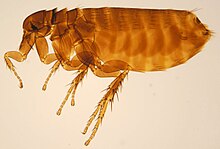Ceratophyllus gallinae
| Ceratophyllus gallinae | |
|---|---|

| |
| Female hen flea | |
| Scientific classification | |
| Kingdom: | |
| Phylum: | |
| Class: | |
| Order: | |
| Family: | |
| Genus: | |
| Species: | C. gallinae
|
| Binomial name | |
| Ceratophyllus gallinae Schrank, 1803
| |
Ceratophyllus gallinae,[1] known as the hen flea in Europe or the European chicken flea elsewhere, is an ectoparasite of birds. It was first described by the German botanist and entomologist Franz von Paula Schrank in 1803.
Description
The adult Ceratophyllus gallinae is some 2 to 2.5 mm (0.08 to 0.10 in) long, laterally flattened and brown. It has a pair of simple eyes, a proboscis for sucking blood, and a characteristic four to six bristles on the femur of the hind leg. The basal segments of the legs do not bear spines.[2]
Hosts
Ceratophyllus gallinae has a broad host range, being associated with a number of species of birds with dry nests, mostly constructed in bushes and trees. It commonly attacks poultry, and can bite humans and other mammals. Another bird flea, Ceratophyllus garei, is associated with the often wet, ground-built nests of ducks, waders and other water birds. A third common bird flea, found on many hosts, is the moorhen flea (Dasypsyllus gallinulae), and this, in contrast to the other two species, hitches a ride on the bird itself rather than living almost exclusively in its nest, and thus becomes widely dispersed. A further species with multiple bird hosts is Ceratophyllus borealis, found in the nests of passerines and cliff-nesting sea birds. C. borealis has been known to hybridise with C. gallinae.[3]
There are reasons to believe that the original host of C. gallinae was a tit, but the flea is now present, via domestic poultry, on numerous islands where there are no representatives of the tit family. This flea has often been recorded from squirrels dreys, and squirrel fleas have been found in birds' nests. When a domestic cat catches a bird, it often plays with it, and as the bird cools, any fleas it carries are likely to transfer to the warm-blooded cat. There they can feed, but whether they can survive for some time and breed on the cat is unclear.[4]
Ecology
Although many species of flea require a blood meal before they can copulate, that is not the case with C. gallinae.[3] As with other fleas, the life cycle consists of eggs, the larval stages, a pupal stage and an adult stage.[4] The larvae have chewing jaws and it is only the adult fleas that are capable of biting the host. Under optimal conditions of temperature and humidity, adults can emerge from the cocoon in 23 days. How many generations there are in the year depends on how many broods their host bird rears.[5] The fleas usually undergo metamorphosis and overwinter as pre-emergent adults. These are fully formed within the cocoon and emerge when certain stimuli occur; suitable stimuli are vibration, heat, or increased levels of carbon dioxide.[6]
Fleas like C. gallinae that are found in nests, often develop a defined breeding season which coincides with that of their host. Associated with this is their ability to survive away from the host. C. gallinae has often been collected far away from its host or the host's nest, under flakes of bark, in cracks or among leaves, where it fasts for an indeterminate period.[4]
The largest number of bird fleas (C. gallinae) reported from a single bird's nest, was 5,754 fleas, from the nest of a coal tit (Periparus ater).[3]
References
- ^ "Ceratophyllus gallinae". The Encyclopedia of Life.
- ^ "Chicken Fleas: Ceratophyllus gallinae Bites". FleaBites.net. Retrieved 30 November 2016.
- ^ a b c Gunvor Brinck-Lindroth; F.G.A.M. Smit † (2007). The fleas (Siphonaptera) of Fennoscandia and Denmark. BRILL. pp. 6–10. ISBN 978-90-474-2075-0.
- ^ a b c Rothschild, Miriam; Clay, Theresa (1953). Fleas, Flukes and Cuckoos. A study of bird parasites. Collins. p. 86–96.
{{cite book}}: CS1 maint: multiple names: authors list (link) - ^ Harper, G.H.; Marchant, A.; Boddington, D.G. (1992). "The Ecology of the Hen Flea Ceratophyllus gallinae and the Moorhen Flea Dasypsyllus gallinulae in Nestboxes". Journal of Animal Ecology. 61 (2): 317–327. JSTOR 5324.
{{cite journal}}: CS1 maint: multiple names: authors list (link) - ^ Crosby, J.T. "What is the Life Cycle of the Flea?". Veterinary Parasites. About Home. Retrieved 30 November 2016.
